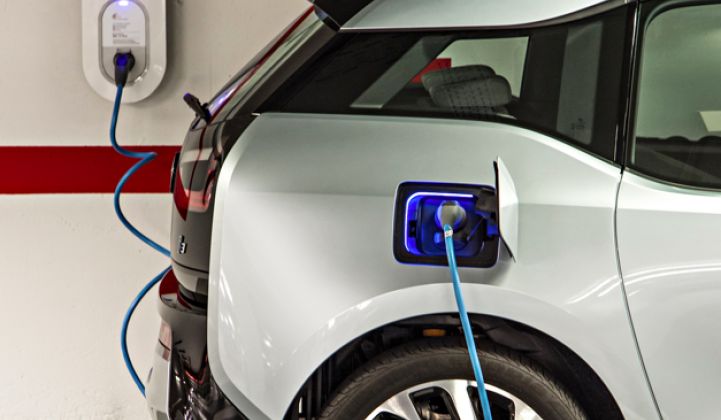The U.K. launched a major vehicle-to-grid (V2G) study last month. But it could still be a long time before the technology goes mainstream.
“V2G projects often get stuck in pilot,” admitted Simon Daniel, CEO of energy storage firm Moixa Energy, which is working on the study as part of a consortium that includes National Grid, Western Power Distribution, the Nissan Technical Centre Europe and others.
The term "vehicle-to-grid" has been around since the mid-2000s, to describe the use of idle car batteries as a source of power that can be used for grid services, such as demand response or frequency regulation.
The idea is attractive because of the growing amount of lithium-ion battery capacity tied up in electric vehicles, and the fact that this capacity is not being used for around 95 percent of the time.
Ten new Nissan Leafs can store as much energy as a thousand homes typically consume in an hour, according to Moixa. However, despite numerous pilot studies over the last decade, V2G has yet to become a commercial reality.
The lack of progress has led some to question the viability of the concept. Doubters include Tesla Motors chief technology officer JB Straubel, who said V2G is "something that I don’t see being a very economic or viable solution -- perhaps ever, but certainly not in the near term."
One major concern with V2G is that allowing a utility to draw on energy storage from stationary vehicles would increase the stress on the batteries, which are one of the most expensive parts of the vehicle.
It is still unclear who would cover the cost of battery replacements and how vehicle owners should be compensated for taking part in V2G programs.
“V2G is intuitively appealing for all the obvious reasons, but it’s not a slam-dunk, at least not in the short term,” said Colin McKerracher, head of advanced transport research at Bloomberg New Energy Finance.
“Private customers are still hesitant, and many of the revenue numbers you see rely on tapping mostly into frequency regulation markets, which are high-value but can quickly become oversupplied.”
The U.K.’s new study, V2GB -- Vehicle to Grid Britain, is one of 21 projects sharing nearly £30 million ($42 million) of government funding to make the country a world leader in low-carbon vehicles.
The research aims to “develop driver-centered business models to support a rapid roll out of V2G technologies, allowing millions of electric car batteries to become a vital part of the U.K. energy system,” said Moixa in a press release.
As part of the study, National Grid and Western Power Distribution are looking into the ways electric vehicles can support the grid and earn revenue.
Nissan’s Technical Centre Europe will contribute data on driver behavior, based on more than 500,000 electric vehicles worldwide.
Moixa and consultancy Cenex will build on a previous V2G pilot that showed vehicles could earn around £60 ($84) a month by using the batteries to help balance supply and demand.
Even if car owners cannot be persuaded to take money in exchange for battery capacity, there may be some mileage in simply trying to get electric vehicles to charge up in a more flexible way, said Moixa’s Daniel. “The major opportunity is in grid-to-vehicle,” he said.
Grid operators worldwide are dealing with growing EV charging requirements. One analysis by Wood Mackenzie last year predicted that just a quarter of a percent of Texas’ cars could sink the grid if they all charged simultaneously.
The U.K. already has 110,000 electric vehicles, equating to 2.2 gigawatt-hours of battery storage, said Daniel. This will rise to almost a terawatt-hour of capacity in the 2030s, he said.
“Such growth creates significant capital upgrade, network and peak management issues, particularly when fast-charging is considered,” he noted.
However, with the right balancing market design, all this capacity could be used to create a sink for excess generation when needed.
Similarly, halting vehicle charging in response to a grid signal could help the electricity network cope with short-term increases in demand.
“This is a complex local software challenge, and advanced technology is required to manage these assets effectively, similar to how broadband rates are throttled when constrained,” Daniel said.
“The main challenges are around peak holidays and on developing the right government policies to encourage the installation of two-way charging points, while taking network upgrade costs into account.”




